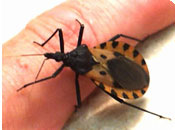Chagas Disease (American Trypanosomiasis)
What is Chagas Disease (American Trypanosomiasis)?

American trypanosomiasis, also known as Chagas disease, is caused by a parasite. This parasite lives in the poop of triatomine (kissing) bugs. The bug often poops when it bites. Most people get Chagas disease by unknowingly rubbing triatomine bug poop into the bug bite when they scratch the bite. People may also accidentally get triatomine bug poop in their eyes and mouth.
A few people experience swelling around the bite area. However, most people never have symptoms, but remain infected throughout their lives.
About 1 out of 3 people who get Chagas disease will develop more serious symptoms later in life, including heart conditions or gastrointestinal problems. These later symptoms can occur whether a person has early symptoms or not.
Who is at risk?

Where are you going?
Chagas disease is spread by triatomine bugs in parts of Mexico, Central America, and South America, especially rural areas.
Most travelers to these areas don’t need to worry about Chagas disease. Travelers who sleep outdoors or stay in poorly constructed housing are more likely to get bitten by triatomine bugs.
What can travelers do to prevent Chagas disease?
There is no vaccine or medicine to prevent Chagas disease. Travelers can protect themselves by taking a few steps.
Avoid Bug Bites
- Stay and sleep in screened or air-conditioned rooms.
- Avoid sleeping in thatch, mud, and adobe housing in areas with triatomine bugs; use insecticides in and around such homes. Insecticide-treated bed nets are helpful
- Cover exposed skin by wearing long-sleeved shirts, long pants, and hats.
- Use EPA-registered insect repellents with one of the following active ingredients: DEET, picaridin, IR3535, oil of lemon eucalyptus (OLE), para-menthane-diol (PMD), or 2-undecanone. Find an EPA-registered insect repellent that’s right for you.
- Always follow product directions and reapply as directed.
- If you are also using sunscreen, apply sunscreen first and insect repellent second.
- When using insect repellent on children
- Do not use products containing oil of lemon eucalyptus (OLE) or para-menthane-diol (PMD) on children under 3 years old.
- Do not apply insect repellent to a child’s hands, eyes, mouth, cuts, or irritated skin.
- Adults: Spray insect repellent onto your hands and then apply to a child’s face.
- Use permethrin-treated clothing and gear (such as boots, pants, socks, and tents). You can buy pre-treated clothing and gear or treat them yourself:
- Treated clothing remains protective after multiple washings. See the product information to find out how long the protection will last.
- If treating items yourself, follow the product instructions carefully.
- Do not use permethrin directly on skin.
After Travel

If you traveled and feel sick, particularly if you have a fever, talk to a healthcare provider and tell them about your travel.
If you need medical care abroad, see Getting Health Care During Travel.
More Information
- Chagas disease FAQs
- Avoid Bug Bites
- CDC Yellow Book: Trypanosomiasis-American